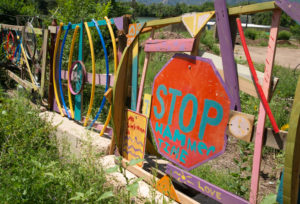COLORADO SPRINGS — The contrast is stark. On two chilly December mornings last year tree branches were bare, and the ground pounded to dust. The smoke of warming fires was counterpointed by the diesel fumes from construction equipment brought in by the City of Colorado Springs to remove more than 168 metric tons of tents, blankets, sleeping bags, trash and the sometimes arcane and inexplicable detritus of life on the street.


The clearance of the homeless encampments on two properties west of S. Royer and north of E. Las Vegas streets was noisy, smelly and dusty. Mostly the residents were depressed and defeated, desperately trying to gather what they could carry as city cleanup crews followed closely behind. Some voices were raised in protest, some in anger, but there was no violence, just resignation that they had to move on.
Eight months later it’s hot, humid and quiet in the riotous jungle of leafed-out saplings and yard-high ragweed, with the occasional happy sunflower poking its head up.
Where an enormous pile of garbage and trash sat near a concrete retaining wall at the front of the Concrete Couch property, the first camp to be cleared, now sits a caretaker’s trailer, some piles of donated lumber and supplies and a kitschy outhouse concealing a porta-potty.

Nearby a tiny orchard and various amenities provide a welcoming entry to what was a place of poverty and desperation.
Craig Cantrell, Site Manager for Concrete Couch, a community-based non-profit that encourages involvement in the betterment of both the community and individuals, said of the dense vegetation, “We’ve had a lot of rain, that helps. We planted an orchard here with the help of Pikes Peak Horticulture Society and Pikes Peak Urban Gardens volunteers.”

The rest of the site is wild, though volunteers have built some amenities. Where a homeless couple once lived and recycled bicycle parts, volunteers built a tiny amphitheater with two rows of stone seats and a small level area for speakers. In other places stone stairs and retaining walls around mature trees have been built.

There’s a feeling of remoteness among the dense growth and the canyon-like topography of the site. It’s the kind of place kids love. Their imaginations can conjure up many a scenario among the trees.
“We’ve done a number of programs this summer with area kids who do the summer camp programs we call SCAMP,” said Cantrell. “We had various themes. We did adventure play, construction, science week and art week. We’ve done some construction with kids. The science week we observed a lot of the plants and made some signs denoting what the plants are.”


Looking to the future Cantrell said, “We’ve been working with some of the hillside neighborhoods doing trail building. Eventually there’s going to be a bike trail that goes around the property, a hiking trail and a disc golf course. We’re trying to create a community-built park.”
“We need the community. We need volunteers to come help,” said Cantrell. “We get a lot of in-kind donations. The community’s been very generous to us. Mainly we want people to take ownership of the place and become involved and help us create a vision of what they think it should be.”

Asked how long he thinks it will take to complete the transition from a dump site to a public park, Cantrell said, “It may never be completed to be honest with you. Steve [Wood, Director of Concrete Couch] and I are both in our late 50s and we don’t know how much longer we can keep doing it. We hope community involvement will come in and keep working the land. It’s such a unique piece of property with the creek running through it. This much land so close to downtown, it’s amazing it’s not been developed already.”

The organization welcomes people to visit and enjoy the site, but with restrictions. “We put signs up saying no trespassing, but we allow people to be on the property. I greet everyone and let them know it’s private property just to cover our liability,” said Cantrell. “We have no problems with people coming in during the day and hanging out. We don’t want people here at night and we don’t want people camping on the property, and we really don’t want people littering. If you pack it in, pack it out.
Prominently advertising the entrance is a new sculpture, an enormous silver hammer designed and built by Clay Bussanich, who graduated from the Classical Academy’s College Pathways program this year. Bussanich discovered an interest in metal-working and welding at Concrete Couch.

“He created that in our fab-lab. We do this fab-lab program once a week at the Manitou Arts Center,” said Cantrell. “It’s 99% recycled materials, the only thing they purchased were the bolts to put it together.”

“He welded the armature and then we created the head and me and some of the kids wrapped the bottom part with some sheet metal that we had donated. It’s a symbol of working to build neighborhood, to build community,” Cantrell continued.
The property, now called “Concrete Coyote,” is located at 1100 South Royer Street, at the south end of Shook’s Run Park.


